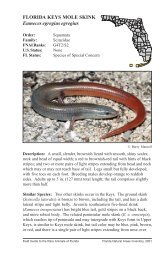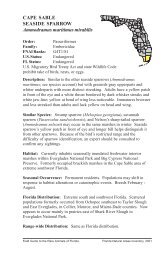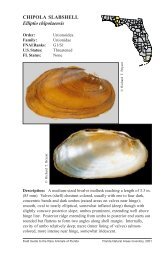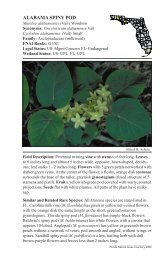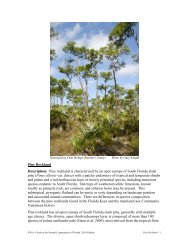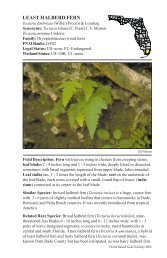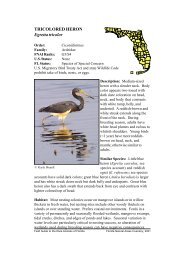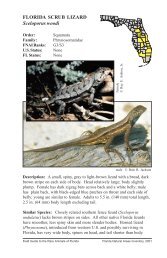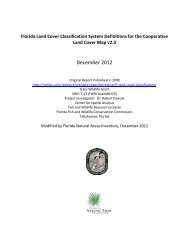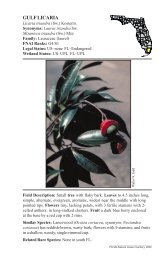AVON PARK HAREBELLS - Florida Natural Areas Inventory
AVON PARK HAREBELLS - Florida Natural Areas Inventory
AVON PARK HAREBELLS - Florida Natural Areas Inventory
You also want an ePaper? Increase the reach of your titles
YUMPU automatically turns print PDFs into web optimized ePapers that Google loves.
<strong>AVON</strong> <strong>PARK</strong> <strong>HAREBELLS</strong><br />
Crotalaria avonensis (K.R. DeLaney & Wunderlin)<br />
Synonyms: none<br />
Family: Fabaceae (pea)<br />
FNAI Ranks: G1/S1<br />
Legal Status: US–Endangered FL–Endangered<br />
Wetland Status: US–UPL FL–UPL<br />
Gil Nelson<br />
Field Description: Perennial herb with hairy stems to 7 inches long, either<br />
bushy or hugging the ground. Leaves simple, entire, alternate; oval, oblong,<br />
to nearly round; somewhat succulent, very hairy, with no stipules. Flowers<br />
are typical pea flowers with an upright banner petal, 2 wings, and a keel<br />
petal; yellow with a few purple lines on the upright petal, in clusters at ends<br />
of stems. Fruit a pod to 1 inch long, inflated, tan, grey, or maroon.<br />
Similar Species: Round-leaved harebell (Crotalaria rotundifolia), a<br />
common species of sandhills, flatwoods, and disturbed areas, is usually<br />
sprawling rather than erect; it flowers year-round and has black pods; it<br />
usually has stipules on the upper leaves.<br />
Related Rare Species: Many members of the pea family are rare in FL. See in<br />
this guide: meadow jointvetch (Aeschynomene pratensis),crenulate leadplant<br />
(Amorpha herbacea var. crenulata), few-flowered nickerbean (Caesalpinia<br />
pauciflora), sand butterfly pea (Centrosema arenicola), Big Pine<br />
partridge pea (Chamaecrista lineata var. keyensis), <strong>Florida</strong> prairie clover<br />
(Dalea carthagenensis var. floridana), and Ocala vetch (Vicia ocalensis).<br />
_______________________________<br />
<strong>Florida</strong> <strong>Natural</strong> <strong>Areas</strong> <strong>Inventory</strong>, 2000
Avon Park harebells Crotalaria avonensis<br />
Habitat: Bare patches of white sand in Lake Wales Ridge scrub; occasionally<br />
in disturbed areas or in partial shade.<br />
Best Survey Season: Flowers March–June; fruits and leaves (lacking<br />
stipules) are distinctive year-round.<br />
Range-wide Distribution: Endemic to Polk and Highlands counties, FL.<br />
Conservation Status: Only 3 populations of Avon Park harebells are known;<br />
2 of these occur on conservation lands.<br />
Protection & Management: Use prescribed fire to create a mosaic of<br />
successional scrub habitats; control exotic plant species; prevent soil<br />
disturbance, trash dumping, off-road-vehicle use, and rock or shell fill along<br />
roadsides near known populations. Maintain plantings in experimental<br />
gardens. Acquire private lands that support this species. Monitor animal<br />
predation.<br />
References: Coile 2000, DeLaney and Wunderlin 1989, Isely 1990, USFWS<br />
1998, Wunderlin and Hansen 2000a.<br />
______________________________<br />
<strong>Florida</strong> <strong>Natural</strong> <strong>Areas</strong> <strong>Inventory</strong>, 2000<br />
leaf shapes<br />
banner petal<br />
keel<br />
wing<br />
seed<br />
opened pod<br />
pod




